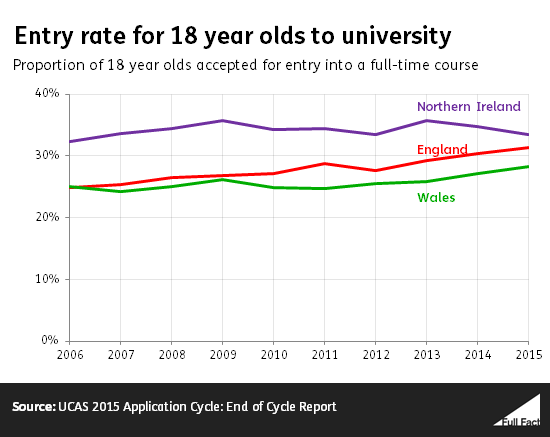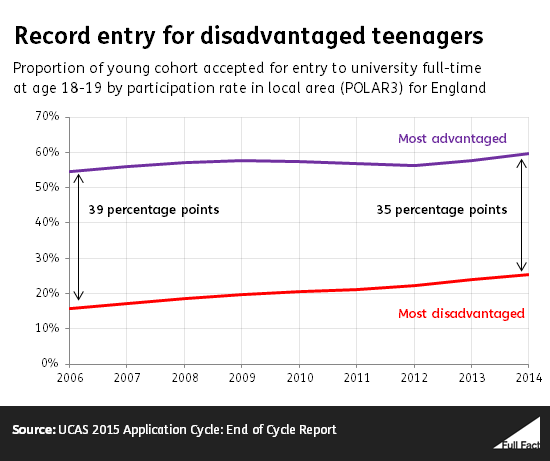"…we have seen record numbers of young people entering higher education, including record numbers from disadvantaged backgrounds…"
Jo Johnson MP, Universities and Science Minister, 1 July 2015
We see this and similar claims coming up again and again.
There are two different ways to look at undergraduate university entrants: the first is how many young people have been accepted for a place at university (UCAS data), the second is how many are there once they've started (government data).
UCAS data shows record numbers and rates of 18 and 19 year olds going to university in England, including those from disadvantaged areas.
The government data for first-time university attendance for 17-20 year olds isn't at a record high. But these figures are a year older than the UCAS ones (so may show a record high when they're updated), and the only year with a higher participation rate was 2011/12, when a higher proportion went to university before the increase in tuition fees a year later.
Advantaged students are still substantially more likely to go to university.
Record rate of young people accepted to university in England and Wales
In 2015, there were 235,000 18 year olds accepted into a full-time place at university, the most ever recorded.
If we want to look at whether young people are becoming more likely to go to university, the better measure is to look at whether the proportion of young people going to university has changed (which accounts for changes in the population).
In 2015, 31% of 18 year olds in England were accepted into a university place (the entry rate)—an increase of almost one percentage point on the previous year and the highest level recorded.
 Entry rates for 18 year olds in Northern Ireland fell slightly in 2015.
Entry rates for 18 year olds in Northern Ireland fell slightly in 2015.
We haven't mentioned Scotland here because not all universities in Scotland use UCAS and data issues have affected comparability of the Scottish figures over time.
While around half of all acceptances to university are 18 year olds, a further fifth are 19 year olds who have applied a year later. To account for this, UCAS provides a cohort entry rate, which measures how many of those in one year group get a place at university when they're 18 or 19. The downside of this is that we don't yet have figures for 2015 because the most recent cohort hasn't yet had the chance to apply at 19.
The cohort entry rates for England and Wales were all the highest on record in 2014. But, for Northern Ireland the cohort entry rate fell by just over one percentage point.
Disadvantaged young people are more likely than ever before to enter higher education
In 2015 the entry rate for 18 year olds living in the most disadvantaged areas was at a record high in England—around 19%—in Wales it has changed very little in comparison to 2014 and is still around 17%. But in Northern Ireland it has fallen very slightly to 16%.
Disadvantage here is measured according to the rate of participation in higher education by young people in each area, so the most disadvantaged areas are those with the lowest rates of participation by young people.
The rate for those in the most advantaged areas in 2015 was at a similar level to that seen in recent years—at 45% in England, 46% in Northern Ireland and 44% in Wales.
The cohort entry rates (available only for England), show a decreasing gap between the likelihood of young people from the most disadvantaged areas of participation going to university and the likelihood of those from the most advantaged areas going to university.
Those from the most advantaged areas are still significantly more likely to go to university though, with the gap in entry rates between the most and the least advantaged areas still at 35 percentage points.
 The other way to look at disadvantage is by income level, which UCAS measure by looking at whether or not a young person was receiving free school meals at age 15.
The other way to look at disadvantage is by income level, which UCAS measure by looking at whether or not a young person was receiving free school meals at age 15.
The entry rate to university of 18 year old state school pupils in receipt of free school meals was also at a record high in 2015—a figure of 16%. That's compared to 31% for those who didn’t receive free school meals.
Participation rate isn't yet at a record high
The other way of looking at how many young people are going to university is by counting them once they're there (rather than when they're accepted for a place).
The Department for Business, Innovation and Skills provides data on how many students from England who have been at university in the UK (or in a higher education course at college) for at least six months are aged 17-30 and at university for the first time. This data has the benefit of including part-timers, while the UCAS data relates only to full-time applicants.
This is two years behind the UCAS data though, so its latest (provisional) figures measure the numbers of young people at university in autumn 2013 while the UCAS data looks at those given a place to start in autumn 2015.
The participation rate of 17-20 year olds based on this data was still below the peak seen in 2011/12—a rate of 40% in 2013/14 compared to 41.5% in 2011/12. But 2011/12 saw particularly high participation because of people seeking to avoid the fee increase in 2012. Compared to the participation rate in 2010/11, the 2013/14 rate is higher.
The release states that the participation rates for 2012/13 onwards signal a return to the trend before 2011/12 of year on year increases in the rate.
Update 25 September 2015
We added in a sentence to explain that the participation rate seems to have returned to the trend of year-on-year increases seen before 2011/12.
Update 1 August 2016
We have updated this piece to include the latest UCAS figures from 2015.
 Entry rates for 18 year olds in Northern Ireland
Entry rates for 18 year olds in Northern Ireland  The other way to look at disadvantage is by income level, which UCAS measure by looking at whether or not a young person was receiving free school meals at age 15.
The other way to look at disadvantage is by income level, which UCAS measure by looking at whether or not a young person was receiving free school meals at age 15.